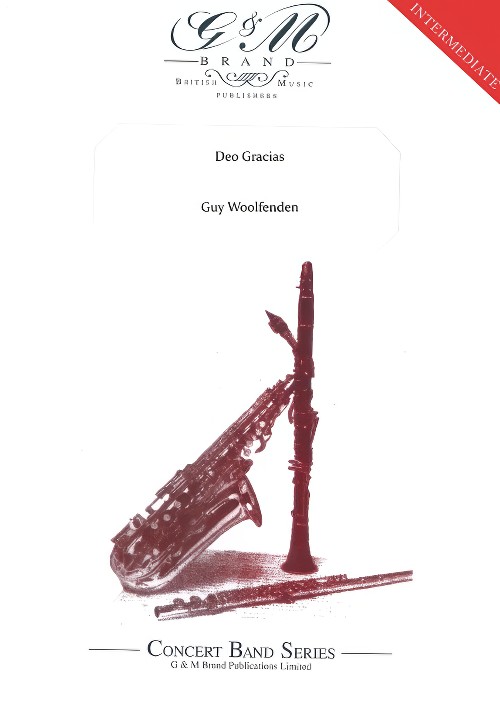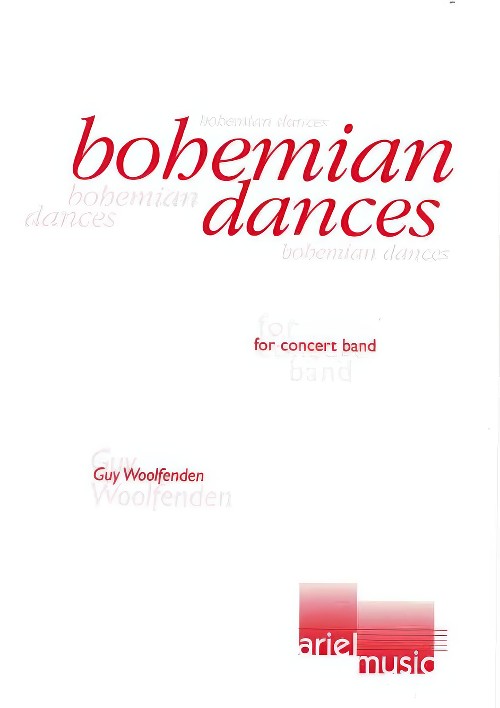Results
-
 £74.95
£74.95Deo Gracias (Concert Band - Score and Parts) - Woolfenden, Guy
Originally written to accompany the Royal Shakespeare Company's production of Henry V, the 3-movement "Deo Gracias" follows the coronation of King Henry V, the victory of the Battle of Agincourt, the betrothal of King Henry and Princess Katharine of France and ends with the optimistic and jaunty 'King's March.'
Estimated dispatch 7-14 working days
-
 £14.95
£14.95Deo Gracias (Concert Band - Score Only) - Woolfenden, Guy
Originally written to accompany the Royal Shakespeare Company's production of Henry V, the 3-movement "Deo Gracias" follows the coronation of King Henry V, the victory of the Battle of Agincourt, the betrothal of King Henry and Princess Katharine of France and ends with the optimistic and jaunty 'King's March.'
Estimated dispatch 7-14 working days
-
 £202.99
£202.99Avalon Wind Band Set (Score & Parts)
The magical world of King Arthur, Merlin and Mordred is the setting for Avalon. Unexpected opening figures portray the sudden entrance into another world. A choral-like melody represents the procession of ghosts headed by the mighty magician Merlin. Suddenly, ostinato figures and bi-tonal motifs indicate the attempt of Mordred and his horde to disturb the peace and quiet in the otherwise calm Avalon. Following a powerful statement of King Arthur, we hear a glissando referring back to the opening bars, and... we are back in the normal world. The journey through the underworld has come to an end and the dream is over. 0:16:20
Estimated dispatch 7-14 working days
-
 £115.00
£115.00BOHEMIAN DANCES (Concert Band) - Woolfenden, Guy
Includes:1. Shepherds and Shepherdesses2. Florizel and Perdita3. Dance of the SatyrsOne of my favourite Shakespeare plays is The Winter's Tale, and I have written music for three completely different productions during my time as Head of Music to the Royal Shakespeare Company. One, starring Judi Dench as both the mother, Hermione and her daughter, Perdita, had a big band Tribal Love-Rock score; another had a more classical, but timeless feel to it, and the last was an excellent small-scale touring production, for which I was allowed only a handful of instruments. It is from this source that the basic themes for Bohemian Dances, and an earlier version Three Dances for Clarinet Choir, have emerged. Act IV of the play is set in the kingdom of Bohemia - hence the title of the work.Shakespeare calls for "A Dance of Shepherds and Shepherdesses", which gives Florizel, the son of Polixenes, (King of Bohemia) a chance to become better acquainted with the beautiful Perdita, the lost daughter of Leontes, (King of Sicilia). This movement is written in seemingly tricky and ever-changing metres, but is rhythmically quite logical and melodically catchy.The slower second movement 'Florizel and Perdita' is the lovers' pas de deux: a gentle, slow waltz-like tune, initially presented by the principal oboe, is contrasted with a lndler-like double time melody, at the end of which a solo clarinet makes a link to the last movement.'Dance of the Satyrs' is a rip-roaring, foot-stamping dance performed in the play by 'three carters, three shepherds, three neat-herds, and three swine-herds', who enter in outrageous costumes representing the lecherous half-man, half-goat of Greek mythology. This dance is referred to as a "gallimaufry of gambols" - now where have I heard that word before?! - GW
Estimated dispatch 7-14 working days
-
 £64.35
£64.35Imperial - Swearingen, James
The long list of newly edited King marches continues to grow by leaps and bounds. You can be assured that this latest selection will be another crowd pleaser for audiences of all ages. It should also be noted that musicians love to revisit the glory days of circus band performances and it just doesn't get any better than this toe tapping march by the great Karl L. King. A real crowd pleaser!
Estimated dispatch 7-14 working days
-
 £139.99
£139.99Le Cortge du Roi Renaud (Concert Band - Score and Parts)
Le cort?ge du roi Renaud is a suite in five parts. It is based on tales that originated in southern European folk songs, dating back as far as the 16th century. A large portion of these songs are of the genre "Complaintes" songs in which the text gives a detailed description of events having a generally criminal or macabre character. The most familiar song to feature the tales of Roi Renaud is "Fualdes", consisting of 48 verses.The first part of the suite is based on the song "La Porcheronne" (The Swineherd). It telis the story of a young woman forced by her mother-in-law to tend pigs while her husband is away fighting in the war. She is freed only when her husband returns seven years later.The next part tells the story of "La mrquise Empoisonn?e" (The Poisoned Marquise). A marquise is coerced by her king to become his mistress. The jealous queen poisons her by means of a bouquet of deadly scented fiowers.Despite having the character of a merry dance, the third part, "La maumari?e vengee" (The Avenged Wedding), expresses the touching story of Queen Clotilde, persecuted for her refusal to live according to the Aryan beliefs."La belle engloutie" (The Swallowed Beauty) relates the tale of the young wife of King Renaud. She cannot imagine a life without her husband, who was mortally wounded in the war, and begs the earth to open and swallow her up so thst she may rejoin her love.The gruesome content of the final part,"Le tueur de femmes" (The Wife Killer), bears a strong resembiance to the tale of Bluebeard. The story is about a young wife in danger of being drowned in a pond by her husband, which is what happened to her 13 predecessors. Thanks to her cunning, she manages to turn the tables and contrive her husband's demise. 09:20
Estimated dispatch 7-14 working days
-
£67.95
Invictus Rex - Matthew N. Putnam
Invictus Rex is the Latin phrase for an invincible or undefeatable king. It calls to mind a paragon of strength, boldness, and confidence in the face of challenges and adversity. Audiences will imagine a medieval king attired in heavy armor confidently leading his men into battle, assured in the idea that, though the battle is to be long and arduous, they will ultimately reign victorious. New composer Matthew Putnam draws on his experience as a music educator to provide us with this piece that students will absolutely love to play.
Estimated dispatch 7-14 working days
-
 £139.99
£139.99Le Cortge du Roi Renaud - Franco Cesarini
Le cortge du roi Renaud is a suite in five parts. It is based on tales that originated in southern European folk songs, dating back as far as the 16th century. A large portion of these songs are of the genre "Complaintes" songs in which the text gives a detailed description of events having a generally criminal or macabre character. The most familiar song to feature the tales of Roi Renaud is "Fualdes", consisting of 48 verses.The first part of the suite is based on the song "La Porcheronne" (The Swineherd). It telis the story of a young woman forced by her mother-in-law to tend pigs while her husband is away fighting in the war. She is freed only when her husband returns sevenyears later.The next part tells the story of "La mrquise Empoisonne" (The Poisoned Marquise). A marquise is coerced by her king to become his mistress. The jealous queen poisons her by means of a bouquet of deadly scented fiowers.Despite having the character of a merry dance, the third part, "La maumarie vengee" (The Avenged Wedding), expresses the touching story of Queen Clotilde, persecuted for her refusal to live according to the Aryan beliefs."La belle engloutie" (The Swallowed Beauty) relates the tale of the young wife of King Renaud. She cannot imagine a life without her husband, who was mortally wounded in the war, and begs the earth to open and swallow her up so thst she may rejoin her love.The gruesome content of the final part,"Le tueur de femmes" (The Wife Killer), bears a strong resembiance to the tale of Bluebeard. The story is about a young wife in danger of being drowned in a pond by her husband, which is what happened to her 13 predecessors. Thanks to her cunning, she manages to turn the tables and contrive her husband's demise.
Estimated dispatch 7-14 working days
-
£202.99
Avalon - Jan van der Roost
The magical world of King Arthur, Merlin and Mordred is the setting for Avalon. Unexpected opening figures portray the sudden entrance into another world. A choral-like melody represents the procession of ghosts headed by the mighty magician Merlin. Suddenly, ostinato figures and bi-tonal motifs indicate the attempt of Mordred and his horde to disturb the peace and quiet in the otherwise calm Avalon. Following a powerful statement of King Arthur, we hear a glissando referring back to the opening bars, and... we are back in the normal world. The journey through the underworld has come to an end and the dream is over.
Estimated dispatch 7-14 working days
-
£271.60
Ljodgata - Torstein Aagaard-Nilsen
The old Norwegian name Ljodgata means the main road. This road (or path) has existed since the iron age. In 12 century christians walked from Oslo to Nidaros (Trondheim) to visit the Cathedral containing the tomb of King Olav the Holy. Part 1 The Tomb and the Church is a musical picture of religious activities in the area. The tomb of King Rakne, one of the largest graves in the northern Europa is now a monument in the area, even if Hovin Church has been a symbol of christianity sincethe 1400 century. Part 2 The Woods of Trandum Pictures the military acitivities that has been going on for more that 250 years. During the 2nd World War, an execution of innocent people took place in the woods. Part 3 Jetset Picture of the present.The international airport at Gardermoen has made the village Jessheim become a town. People now live moderne city lives.
Estimated dispatch 7-14 working days
